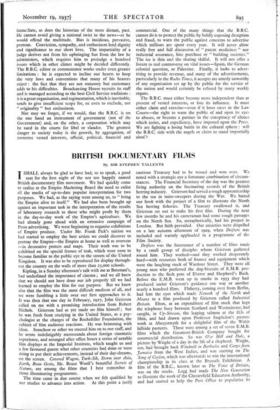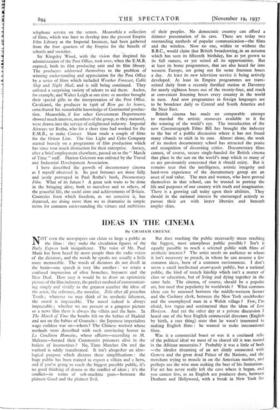BRITISH DOCUMENTARY FILMS
By SIR STEPHEN TALLENTS
-I. SHALL always be glad to have had, so to speak, a good seat for the first night of the not too happily named British documentary film movement. We had quickly come to realise at the Empire Marketing Board the need to enlist all the media of up-to-date popular interpretation for two purposes. We had, as the saying went among us, to " bring the Empire alive to itself." We had also been brought up against an important task in the interpretation of the results of laboratory research to those who might profit by them in the day-to-day work of the Empire's agriculture. We had already gone ahead with an extensive campaign of Press advertising. We were beginning to organise exhibitions of Empire produce. Under Mr. Frank Pick's tuition we had started to employ the best artists we could discover to portray the Empire—the Empire at home as well as overseas —in decorative posters and maps. Their work was to be exhibited on the special frames of teak, which were soon to become familiar to the public eye in the streets of the United Kingdom. It was also to be reproduced for display through- out the country on the walls of more than 25,000 schools.
Kipling, in a Sunday afternoon's talk with me at Bateman's, had underlined the importance of cinema ; and we all knew that we should not have done our job properly till we had learned to employ the film for our purpose. But we knew also that the film was the most difficult medium of all, and we were fumbling a little over our first approaches to it. It was then that one day in February, 1927, John Grierson called on me with a promising introduction from Robert Nichols. Grierson had as yet made no film himself ; but he was fresh from studying in the United States, as a psy- chologist at the charges of the Rockefeller Foundation, the subject of film audience reactions. He was brimming with ideas. Somehow or other we steered him on to our staff, and he wrote indefatigably memoranda about foreign cinematic experience, and arranged after office hours a series of notable film displays at the Imperial Institute, which taught us and a few favoured guests what other countries had done or were doing to put their achievements, instead of their day-dreams, on the screen. Covered Wagon, Turk-Sib, Storm over Asia, Earth, Beau Geste, Mr. Bruce Woolf's beautiful Secrets of Nature, are among the films that I best remember in those illuminating programmes. The time came in due course when we felt qualified by our studies to advance into action. At this point a justly cautious Treasury had to be wooed and won over. We noted with a strategic eye a fortunate combination of circum- stances. The Financial Secretary of the day was the greatest living authority on the fascinating records of the British herring industry. Grierson had served a tough apprenticeship to the sea in mine-sweepers during the War. We baited our hook with the project of a film to illustrate the North Sea herring fisheries. The Treasury swallowed it, and Grierson set out to make his first film. During the next few months he and his cameraman had some rough passages on the North Sea. So, metaphorically, had his project in London. But faith prevailed. Our anxieties were dispelled on a late autumn afternoon of 1929, when Drifters was included and warmly applauded in a programme of the Film Society.
Drifters was the forerunner of a number of films made by a small group of disciples whom Grierson gathered round him. They worked—and they worked desperately hard—with resources both of finance and equipment which were the laughing stock of Wardour Street. They were all young men who preferred the dog-biscuits of E.M.B. pro- duction to the flesh pots of Elstree. and Shepherd's Bush. Before the E.M.B. went up in smoke in 1933 they had produced under Grierson's guidance one way or another nearly a hundred films. Flaherty, coming over from Berlin, had lent the eyes which made Nanook of the North and Moana to a film produced by Grierson called Industrial Britain. Elton, at an expenditure of film stock that kept the telephone busy between Scotland and Westminster, had caught, in Up-Stream, the leaping salmon at the ails of Shin, and had drawn upon Professor Stapledon's pasture work at Aberystwyth for a delightful film of the Welsh hillside pastures. These were among a set of seven E.M.B. films which the Gaumont-British Company bought for commercial distribution. So was O'er Hill and Dale, a picture by Wright of a day in the life of a shepherd. Wright, too, had brought back Windmill in Barbados and Cargo from Jamaica from the West Indies, and was starting on The Song of Ceylon, which was afterwards to win the international championship in its class at the Brussels Exhibition. A film of the B.B.C., known later as The Voice of Britain, was on the stocks. Legg had made The New Generation to illustrate the work of the Chesterfield Education Authority, and had started to help the Post Office to popularise its telephone service on the screen. Meanwhile a collection of films, which was later to develop into the present Empire Film Library at the Imperial Institute, had been gathered from the four quarters of the Empire for the benefit of schools and societies.
Sir Kingsley Wood, with the vision that aspired his administration of the Post Office, took over, when the E.M.B. expired, both its film producing unit and its film library. The producers addressed themselves to the problem of winning understanding and appreciation for the Post Office by a series of films which included Weather Forecast, Cable Ship and Night Mail, and is still being continued. They enlisted a surprising variety of talents to aid them. Auden, for example, and Walter Leigh at one time or another brought their special gifts to the interpretation of the Post Office. Cavalcanti, the producer in 1926 of Rien que les heures, contributed his remarkable knowledge of Continental produc- tion. Meanwhile, if few other Government Departments showed much interest, members of the group, as they matured, were drawn into the service of enlightened industry. Imperial Airways set Rotha, who for a short time had worked for the E.M.B., to make Contact. Shaw made a couple of films for the Orient Line. The Gas Light and Coke Company started bravely on a programme of film production which has since won much distinction for their enterprise. Anstey, after a brief employment elsewhere, passed on to the " March of Time " staff. Marion Grierson was enlisted by the Travel and Industrial Development Association.
I have described the growth of documentary cinema as I myself observed it. Its past fortunes are more fully and justly portrayed in Paul Rotha's book, Documentary Film. What of its future ? A great task waits to be done in the bringing alive, both to ourselves and to others, of the peaceful life, the social aims and achievements of Britain. Countries from which freedom, as we conceive it, has departed, are doing more than we to dramatise in simple terms for common understanding the virtues and ambitions of their peoples. No democratic country can afford a dimmer presentation of its case. There are today two outstanding methods of popular communication—the films and the wireless. Now no one, within or without the B.B.C., would claim that British broadcasting, in an autumn which has seen its fifteenth birthday, has as yet grown to its full stature, or yet seized all its opportunities. But at least its home programmes, that are also heard far into western Europe, are going out for some fourteen hours a day. At least its new television service is being actively developed. At least its Empire programmes are trans- mitted daily from a recently fortified station at Daventry for nearly eighteen hours out of the twenty-four, and reach at convenient listening hours every country in the world in turn. And now programmes in foreign languages are to be broadcast daily to Central and South America and the Near East.
British cinema has made no comparable attempt to marshal the artistic resources available to it for the winning of the world's eye. The introduction of the new Cinematograph Films Bill has brought the industry to the bar of a public discussion where it has not found many ribands to stick in its coat. Almost alone, the work of its modest documentary school has attracted the praise and recognition of discerning critics. Documentary films cannot, of course, secure single-handed for British cinema that place in the sun on the world's map which so many of us are passionately concerned that it should enjoy. But it remains true that the intelligence, artistic integrity and hard-won experience of the documentary group are an asset of real value. The men and women, who have proved themselves in that school, can be trusted to portray the life and purposes of our country with truth and imagination. There is a growing call today upon their abilities. They should in the national interest be encouraged actively to pursue their art with larger liberties and beneath ampler skies.

















































































































 Previous page
Previous page